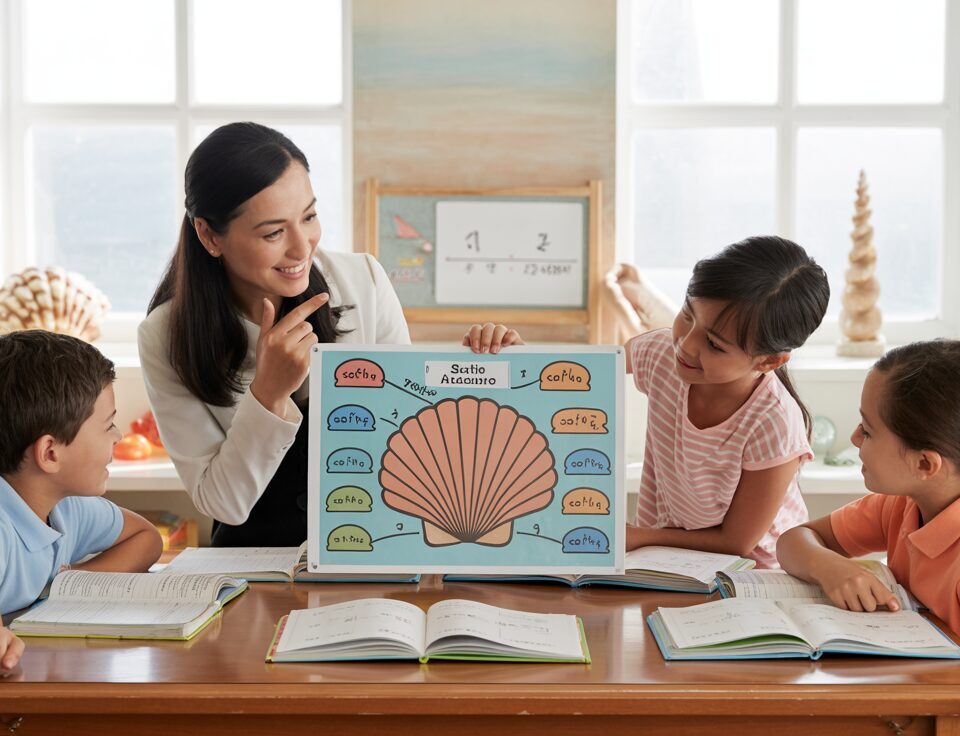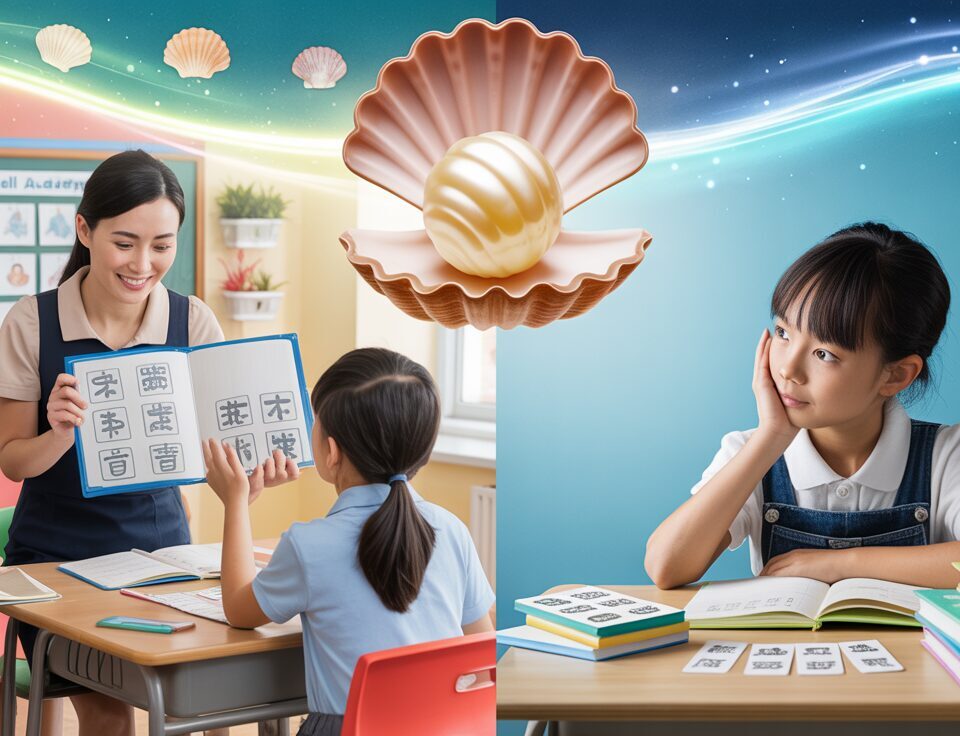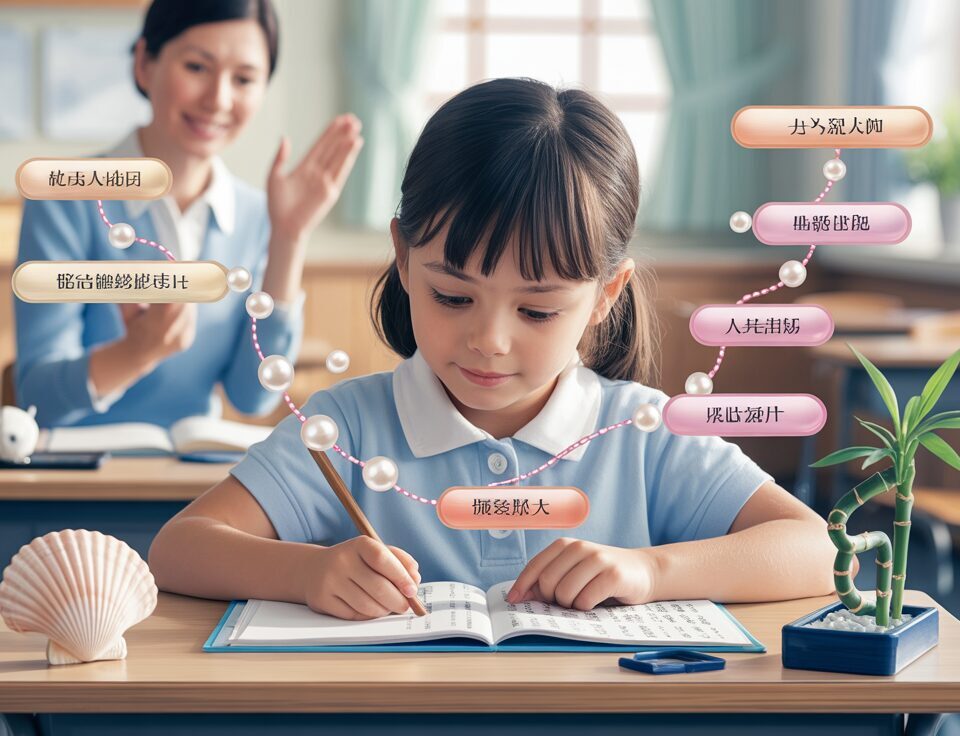
How to Choose the Right Math Assessment Books for Your Primary School Child
October 21, 2025
5 Hands-On Magnet Experiments for P3 Students: Making Science Fun and Educational
October 23, 2025Table Of Contents
- Introduction to PSLE Science Themes
- Understanding the Energy Theme
- Mastering the Cycles Theme
- Exploring the Systems Theme
- Understanding the Interactions Theme
- The Seashell Academy Approach to Science Themes
- Conclusion: Building Strong Science Foundations
PSLE Science Themes Explained: Understanding Energy, Cycles & Core Concepts
The Primary School Leaving Examination (PSLE) Science syllabus is built around several key themes that form the foundation of scientific understanding. These themes—Energy, Cycles, Systems, and Interactions—are not just examination topics but fundamental concepts that help children make sense of the world around them. At Seashell Academy by Suntown Education Centre, we understand that mastering these themes is crucial for both PSLE success and developing a lifelong appreciation for science.
Many students struggle with science because they memorize facts without truly understanding the underlying principles. This approach often leads to confusion when questions are presented in unfamiliar contexts. By gaining a deep understanding of the core themes in PSLE Science, students develop the ability to apply their knowledge to various scenarios, which is exactly what the examination tests.
In this comprehensive guide, we’ll break down each PSLE Science theme into digestible concepts, explore their real-world applications, and share effective learning strategies that have helped our students excel. Whether your child finds science challenging or is looking to refine their understanding, this article will provide valuable insights into the thematic approach that makes science both accessible and engaging.
Understanding the Energy Theme
Energy is one of the most fundamental concepts in science and appears throughout the PSLE Science syllabus. It’s also a concept that students frequently misunderstand or have difficulty applying to different contexts. At Seashell Academy by Suntown Education Centre, we approach the Energy theme by connecting it to everyday experiences before diving into scientific explanations.
Forms of Energy
In the PSLE Science syllabus, students need to understand various forms of energy, including:
Heat energy is all around us—from the warmth of the sun to the heat from a cooking stove. When teaching this concept, we help students recognize that heat always flows from a warmer object to a cooler one. This understanding helps explain phenomena like why ice melts when left outside and why we feel cool when standing in front of an open refrigerator.
Light energy is another critical form students must comprehend. We explain how light travels in straight lines and can be reflected, refracted, or absorbed. These properties help explain everyday observations like why we see rainbows after rain or how mirrors work. By connecting these concepts to real-life scenarios, students develop a deeper understanding beyond textbook definitions.
Sound energy is particularly interesting to students when they realize that sound needs a medium to travel through, unlike light. We demonstrate this concept through engaging experiments showing how sound travels through different materials at different speeds, helping students visualize these invisible energy waves.
Electrical energy powers our modern world, and students need to understand both how it’s generated and how it flows through circuits. Our students learn to distinguish between series and parallel circuits and understand how electrical energy transforms into other energy forms in various appliances.
Energy Conversion
One of the most challenging aspects of the Energy theme is understanding energy conversion. Many PSLE questions test students’ ability to identify energy conversions in various scenarios. For example, when a torch is switched on, chemical energy from the batteries is converted to electrical energy and then to light energy (and some heat energy).
We teach students to trace energy flows and identify each conversion that occurs. This skill is particularly important in questions about energy efficiency and conservation. Students learn that energy is never created or destroyed, only converted from one form to another, which is the Law of Conservation of Energy.
A common area where students struggle is identifying multiple energy conversions in a single process. For instance, in a simple action like kicking a ball, chemical energy from food is converted to kinetic energy in the leg, which is then transferred to the ball. By breaking down these processes step-by-step, students develop the analytical thinking needed for more complex scenarios.
Real-world Applications
At Seashell Academy, we believe that understanding energy concepts becomes meaningful when students can connect them to real-world applications. When discussing renewable energy sources like solar panels, students apply their knowledge of light energy conversion. When learning about electrical appliances, they understand why certain devices produce heat as a by-product.
Students also explore energy efficiency and conservation, topics that have become increasingly important in our resource-conscious world. By understanding energy conversions, they can explain why certain actions save energy and others waste it. These connections make the Energy theme relevant and memorable, which helps students respond confidently to application-based questions in the PSLE.
Mastering the Cycles Theme
The Cycles theme helps students understand the repeating patterns in nature and how materials and energy flow through systems. This theme appears throughout the PSLE Science syllabus in various forms, from life cycles of plants and animals to the water cycle and matter cycles.
The Water Cycle
The water cycle is perhaps the most recognizable cycle in the PSLE Science syllabus. Students need to understand how water moves through the environment in a continuous cycle of evaporation, condensation, and precipitation. At Seashell Academy, we go beyond simply naming these stages—we help students understand the energy transfers involved and how these processes shape our environment.
Students often confuse evaporation and boiling, so we clarify that evaporation occurs at any temperature (not just 100°C) and happens only at the surface of the liquid. We also explore factors that affect evaporation rates, such as temperature, surface area, and air movement. By understanding these details, students can better apply their knowledge to novel situations in the PSLE.
The water cycle also provides an opportunity to discuss the importance of water conservation and how human activities impact this natural cycle. These discussions help students connect scientific knowledge to environmental stewardship, an important aspect of scientific literacy.
Life Cycles
Life cycles of plants and animals form another significant part of the Cycles theme. Students need to understand the stages of development in various organisms and recognize the patterns of growth and reproduction. A common challenge for students is distinguishing between complete and incomplete metamorphosis in insects, or understanding the differences between the life cycles of mammals, amphibians, and insects.
At Seashell Academy by Suntown Education Centre, we use visual aids and comparative analyses to help students recognize these patterns. We encourage students to identify the similarities and differences between different life cycles, developing their skills in classification and pattern recognition—abilities that are essential for the PSLE Science examination.
Students also learn about plant life cycles, including germination, growth, flowering, and seed production. By understanding these cycles, students can explain phenomena such as seasonal changes in plant behavior and the roles of different plant parts in reproduction.
Matter Cycles
The PSLE Science syllabus also introduces students to how matter cycles through ecosystems. While not covered in great detail at the primary level, students should understand basic concepts like food chains and how materials like carbon and nitrogen cycle through living and non-living systems.
We help students visualize these cycles by connecting them to everyday observations. For instance, when discussing decomposition, we explain how fallen leaves break down and return nutrients to the soil, which are then taken up by plants, illustrating a simple matter cycle. These connections help students appreciate that science explains the natural processes they observe around them.
Exploring the Systems Theme
The Systems theme focuses on how different parts work together to perform specific functions. In the PSLE Science syllabus, students encounter systems at various levels, from cells and organs to electrical circuits and ecosystems. Understanding how components interact within a system is crucial for answering many application-based questions.
Human Body Systems
Human body systems are a significant component of the PSLE Science examination. Students need to understand the digestive, respiratory, circulatory, and other systems, including how these systems interact with one another. A common challenge is remembering the specific functions of different organs and how they work together.
At Seashell Academy, we use the analogy of a city to help students understand body systems. The digestive system is like a food processing factory, breaking down food into nutrients. The circulatory system resembles a transportation network, delivering these nutrients (and oxygen) to cells around the body. This approach helps students visualize the interconnectedness of body systems.
We also emphasize the importance of healthy habits in maintaining these systems. By discussing how diet affects the digestive system or how exercise impacts the circulatory system, students understand the practical implications of their scientific knowledge—a connection that makes learning more meaningful and memorable.
Plant Systems
Plants have their own specialized systems for obtaining water and nutrients, producing food through photosynthesis, and responding to their environment. Students often struggle with the concept of plants making their own food, confusing it with how plants obtain water and minerals from soil.
We clarify these misconceptions by explaining that plants have a transport system similar to our circulatory system, moving water and minerals from the roots up to the leaves. We then explain how leaves serve as the plant’s food factories, converting light energy into chemical energy through photosynthesis.
Students also learn about plant responses, such as phototropism (growing toward light) and gravitropism (roots growing downward). These concepts illustrate how plant systems, while different from animal systems, are equally sophisticated and adapted to the plant’s needs.
Electrical Systems
Electrical systems, particularly circuits, are another important aspect of the Systems theme. Students need to understand how components like batteries, bulbs, and switches work together to create a functioning circuit. They also need to distinguish between series and parallel circuits and predict how changes to the circuit will affect its operation.
Through hands-on activities at Seashell Academy, students build and test various circuits, developing both theoretical understanding and practical skills. They learn to trace the flow of electricity through a circuit and identify the energy conversions that occur at different points. This concrete experience helps them visualize abstract concepts like current and resistance.
We also connect electrical systems to everyday technology, explaining how the principles students learn apply to devices they use daily. This connection between classroom learning and real-world technology helps students appreciate the relevance of scientific knowledge.
Understanding the Interactions Theme
The Interactions theme explores how objects, organisms, and systems affect one another. This theme appears throughout the PSLE Science syllabus, from physical interactions like forces to ecological interactions between living things and their environment.
Forces and Interactions
Forces represent a fundamental type of interaction in the physical world. Students need to understand different types of forces, including gravity, friction, magnetism, and elastic forces, as well as how these forces affect the motion and shape of objects.
A common challenge is visualizing these invisible forces and their effects. At Seashell Academy by Suntown Education Centre, we use demonstrations and analogies to make forces tangible. For instance, we might use a tug-of-war to illustrate balanced and unbalanced forces, or rolling balls on different surfaces to show how friction affects motion.
Students also explore magnetic interactions, learning how magnets attract or repel each other and how this principle is applied in everyday devices. By connecting these concepts to technologies like maglev trains or electronic devices, students see how understanding interactions leads to practical innovations.
Environmental Interactions
Environmental interactions focus on how living things interact with one another and with their non-living environment. Students learn about food chains and webs, habitat adaptation, and how changes in an ecosystem affect the organisms within it.
A challenging aspect of this topic is understanding the ripple effects of changes in an ecosystem. We help students develop this understanding through scenario-based discussions: “What would happen if all the frogs in a pond disappeared?” or “How would deforestation affect the animals in a forest?” These discussions develop the critical thinking skills needed for application questions in the PSLE.
Students also explore how humans interact with the environment, both positively and negatively. This includes topics like conservation, pollution, and sustainable practices. By understanding these interactions, students develop awareness of their own role in environmental stewardship.
The Seashell Academy Approach to Science Themes
At Seashell Academy by Suntown Education Centre, our approach to teaching PSLE Science themes is guided by our unique Seashell Method. This method combines academic excellence with emotional well-being, recognizing that effective learning happens when students feel supported and engaged.
We begin by building a strong foundation in each theme, ensuring students understand core concepts before moving on to more complex applications. Our educators use mind-mapping techniques to help students visualize the connections between different themes and concepts. For instance, a mind map might show how the energy theme connects to both electrical systems and the water cycle through energy transformations.
Interactive lessons and hands-on experiments bring abstract concepts to life. Instead of simply reading about circuits, students build them. Rather than memorizing the water cycle, they observe it in miniature using simple materials. These experiences create stronger neural pathways, making knowledge more accessible during examinations.
Our small class sizes allow for personalized coaching, addressing each student’s specific challenges with particular themes or concepts. Some students struggle with the abstract nature of energy, while others find systems complex. Our MOE-trained educators identify these challenges and provide targeted support, ensuring no student is left behind.
Perhaps most importantly, we emphasize real-world applications of scientific themes. When students understand how science explains the world around them, learning becomes more meaningful and retention improves significantly. This approach doesn’t just prepare students for the PSLE—it develops a genuine appreciation for science that extends beyond examinations.
Through our Programme Philosophy, we’ve developed effective strategies for making complex scientific themes accessible to primary school students. Our Mathematics Programme also complements the Science curriculum, reinforcing the logical thinking and problem-solving skills needed for scientific understanding.
Conclusion: Building Strong Science Foundations
The thematic approach to PSLE Science—focusing on Energy, Cycles, Systems, and Interactions—provides students with a framework for understanding scientific concepts and their applications. By mastering these themes, students develop not just the knowledge needed for examination success, but also the critical thinking skills essential for future academic pursuits.
At Seashell Academy by Suntown Education Centre, we recognize that science education is about more than memorizing facts—it’s about understanding the world through a scientific lens. Our approach nurtures students’ natural curiosity while building their confidence in applying scientific concepts to unfamiliar scenarios—exactly what the PSLE Science examination requires.
The journey through primary school science lays the foundation for future learning in secondary school and beyond. By developing a strong understanding of these fundamental themes, students are well-prepared for more advanced scientific concepts. More importantly, they develop a genuine love for learning that extends far beyond examinations.
Whether your child is just beginning their PSLE preparation or looking to strengthen specific areas, understanding these core themes provides a solid foundation for success. Science becomes less intimidating and more fascinating when viewed through the lens of these interconnected themes.
If you’re interested in learning more about how Seashell Academy by Suntown Education Centre can support your child’s PSLE Science preparation, we invite you to contact us for a consultation. Our experienced educators are dedicated to nurturing confident, resilient learners who not only excel in examinations but develop a lifelong love for learning.





